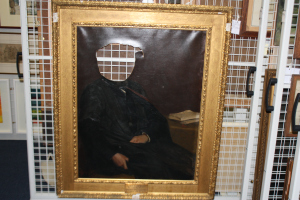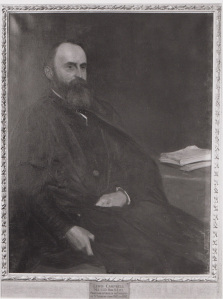The University of St Andrews cares for over 112,000 objects and artworks. Some of them are fairly new, some of them are literally millions of years old. We often think about objects in terms of how they were used, who created them or where they came from, but we rarely think about the stories behind them. Imagine, however, what objects could tell us if they could talk. If objects had eyes, what would they have seen?
Our first story in this series of blogs comes from an object that did once have eyes, but alas! No longer. This portrait, painted by Arthur Lemon in the late 19th century, did show Lewis Campbell, the University’s Professor of Greek between 1863 and 1892. As you can see, however, the distinguished Professor has since lost his face.

You may think he was inspired by John Travolta and Nicolas Cage, but you’d be wrong. Professor Campbell was left in this sorry state by an act of cruel vandalism carried out in the 1990s. At the time the portrait was hanging on a staircase in Swallowgate, the School of Classics. Our records state that the damage occurred in 1990. Some dispute this, however. Another painting that one Professor believes to have been damaged at the same time, in Lower College Hall, didn’t enter the collection until 1995 and another Professor of Classics who remembers the event thinks there were staff in the department at the time of the vandalism who were not at the University in 1990.
This cannot be the case, however. A letter from May 1993 states that the portrait was already damaged by this time and again dates the damage to 1990.
There is disagreement over what time of day the damage was discovered too. One Professor believes that the School secretary entered the building early on a Monday morning and was “freaked out” on seeing the faceless portrait staring down at her (or not, as the case may be). This, he says, would mean that the attack took place over the weekend and was done by someone with a key, or that it had happened after the Friday evening research seminar. Another member of the department says that Professor Campbell’s predicament was discovered mid-morning and that he had walked past the portrait already that day. Had the damage occurred during the day or had our witness been too busy pondering the finer details of Socrates and not noticed our poor Professor?
If objects could talk, and if Professor Campbell’s face were ever discovered, he might be able to tell us when the damage took place, and indeed share with us the identity of the culprit. The truth is, we’ll never know who did it or when.

By a stroke of luck, a photograph of the painting was requested by an American researcher in August 1990, not long before the damage occurred, and a visual record of the artwork was thus made for the first time, allowing us to see what Professor Campbell looked like before his face was so viciously attacked. The photograph really was a stroke of luck given that the researcher in question was looking for images of works by John McLure and was under the mistaken belief that our Professor of Greek was the work of this artist, which, as we know, he wasn’t. Sometimes mistakes can have happy endings. (Though not for the researcher, who published the mistake in a book. Oops!)